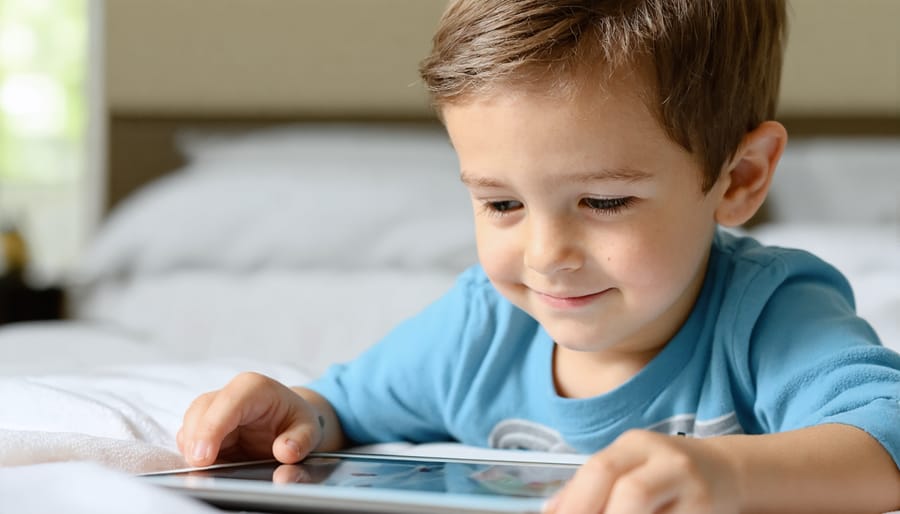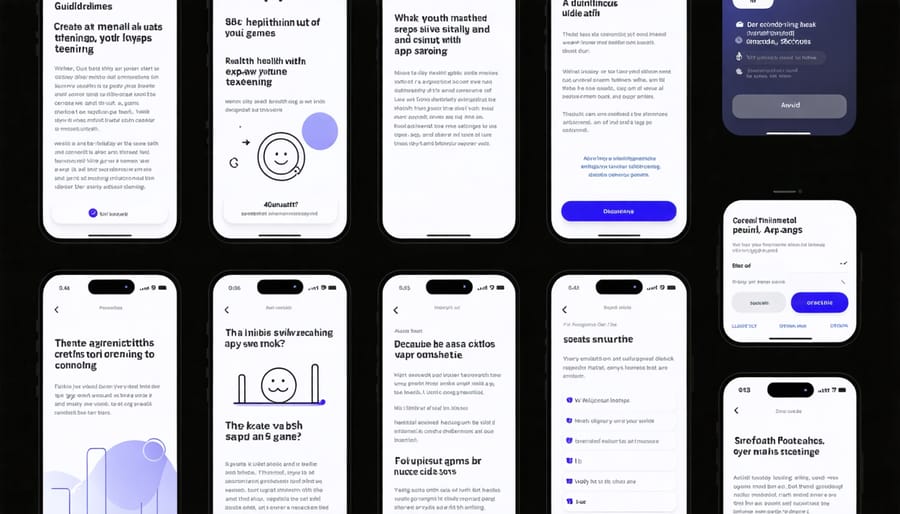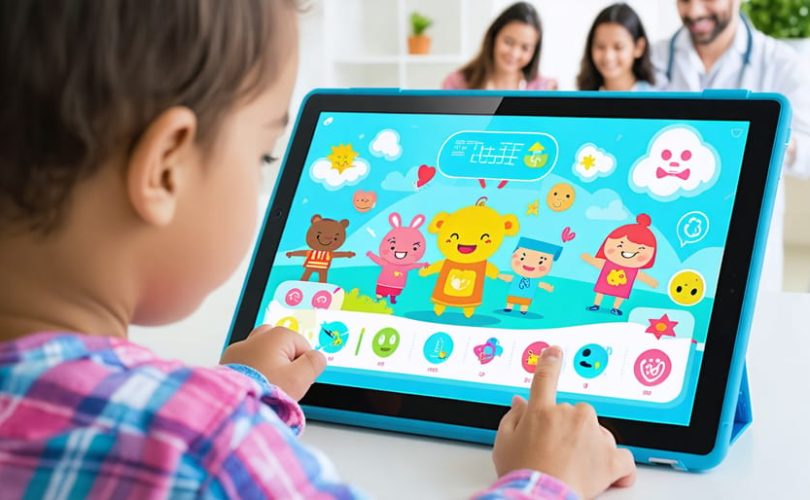Detecting mental health challenges early can dramatically improve outcomes for young people, making reliable screening tools essential for protecting children’s mental health. Today’s digital assessments and standardized questionnaires offer unprecedented opportunities to identify potential concerns before they escalate into serious issues.
Recent studies show that 1 in 6 youth experience mental health challenges, yet more than 80% go undiagnosed during crucial developmental years. Modern screening tools – from validated mobile apps to classroom-based assessments – now enable parents, educators, and healthcare providers to monitor emotional well-being systematically and compassionately.
These evidence-based tools don’t just identify potential concerns; they open vital conversations about mental health between young people and their support systems. When implemented thoughtfully, they create safe spaces for youth to express their feelings while providing professionals with actionable data to guide intervention strategies.
As we embrace these innovative approaches to youth mental health screening, it’s crucial to understand both their capabilities and limitations. This guide explores the most effective tools available today, offering practical guidance for selecting and implementing screening programs that serve our young people with sensitivity and scientific rigor.
Why Digital Screening Tools Matter for Your Child’s Mental Health
Making Mental Health Checks Less Intimidating
Digital screening tools are revolutionizing how we approach communicating with children about mental health, making the process less daunting for young people. Instead of sitting face-to-face in a clinical setting, children can express their feelings through engaging, game-like interfaces on tablets or smartphones.
These digital tools often use friendly characters, colorful designs, and age-appropriate language that helps children feel more at ease. For example, some apps allow kids to select emoji-like expressions to describe their emotions or use interactive stories where they can relate to characters facing similar challenges.
Sarah Chen, a child psychologist, shares, “When children use digital screening tools, they often feel more in control. They can take their time, think about their answers, and express themselves without feeling watched or judged.”
Parents report that their children are more likely to open up about their feelings when using these digital formats, as the familiar technology creates a comfortable bridge between their daily experiences and mental health discussions.

Early Detection That Makes a Difference
Early detection of mental health challenges in young people can dramatically alter their life trajectory. When we identify concerns early, we can intervene before issues become more severe, helping children develop healthy coping mechanisms and resilience from the start.
Digital screening tools have revolutionized this process, making it easier than ever to spot potential concerns. Dr. Sarah Chen, a child psychiatrist, shares, “We’re seeing remarkable improvements in outcomes when we catch signs early. Digital tools help us reach more children and create a comfortable space for them to express their feelings.”
Consider the story of 14-year-old Maya, whose school implemented routine digital screenings. The process identified her developing anxiety symptoms before they impacted her academics or relationships. With early support, Maya learned valuable coping strategies and continued to thrive.
These screening tools also help reduce the stigma around mental health discussions. They normalize regular emotional check-ins and create opportunities for open conversations between children, parents, and healthcare providers. When combined with proper follow-up care, early detection through digital screening becomes a powerful foundation for lifelong mental wellness.
Popular Digital Screening Tools for Children
App-Based Assessment Tools
In today’s digital age, smartphone applications have become valuable tools for mental health screening in young people. These apps offer a comfortable, private way for youth to express their feelings and track their emotional well-being.
Popular apps like MoodKit and Mood Meter help young people identify and track their emotions through user-friendly interfaces and age-appropriate activities. These tools often use engaging graphics, mood journaling features, and interactive questionnaires that appeal to tech-savvy youth.
Dr. Sarah Chen, a child psychiatrist, notes, “App-based screening tools can serve as an excellent first step in identifying potential mental health concerns. They create a safe space for young people to explore their feelings without fear of judgment.”
Many of these apps incorporate validated screening measures like the PHQ-A (Patient Health Questionnaire for Adolescents) and GAD-7 (Generalized Anxiety Disorder-7) in youth-friendly formats. Some popular options include:
– Mindshift CBT: Designed specifically for teens dealing with anxiety
– Virtual Hope Box: Offers coping tools and positive distractions
– Calm Harm: Provides support for managing urges to self-harm
– Smiling Mind: Features age-specific meditation and mindfulness exercises
While these apps shouldn’t replace professional mental health assessment, they can help identify warning signs early and encourage open conversations about mental health. Parents and educators should actively participate in choosing appropriate apps and monitor their use to ensure they’re beneficial for the young person’s needs.
Online Questionnaires and Surveys
Online mental health screening tools have revolutionized how we identify potential concerns in young people, offering a convenient and youth-friendly approach to initial assessment. Many teenagers feel more comfortable sharing their thoughts and feelings through digital platforms, making these tools particularly effective for early detection.
Popular platforms like MindWise and YouthWise provide age-appropriate questionnaires that can be completed privately at home or in school settings. These tools typically assess various aspects of mental health, including anxiety, depression, eating disorders, and social relationships, using engaging interfaces and simple language that resonates with young people.
Dr. Sarah Chen, a child psychologist, notes: “Digital screening tools can serve as an excellent first step in identifying potential mental health concerns. They remove many barriers to seeking help and can make the process less intimidating for youth.”
Key benefits of online screening tools include:
– 24/7 accessibility
– Immediate preliminary results
– Privacy and confidentiality
– Reduced stigma
– Easy sharing of results with healthcare providers
However, it’s important to remember that these tools are meant for screening purposes only and shouldn’t replace professional evaluation. They work best when used as part of a comprehensive approach to mental health monitoring, involving parents, teachers, and healthcare providers.
When selecting an online screening tool, look for those developed by reputable organizations and validated for use with young people. Many schools now incorporate these digital assessments into their student wellness programs, creating a systematic approach to identifying students who might need additional support.
Interactive Games and Activities
Interactive screening tools have revolutionized how we approach mental health assessments for young people. By incorporating gaming elements and engaging activities, these tools help children feel more comfortable sharing their thoughts and feelings.
Popular examples include “How Are You Feeling?” – a colorful app where children select emoji-like faces to express their emotions, and “Mood Journey,” which lets kids create an avatar that navigates different scenarios representing common emotional challenges.
Digital storytelling platforms allow children to share their experiences through character creation and narrative choices, providing valuable insights into their mental state. “Mind Heroes” encourages children to complete missions that subtly assess anxiety, depression, and social interaction patterns while maintaining a fun, game-like atmosphere.
Several tools use reward systems and achievement badges to maintain engagement. For instance, “Feelings Forest” asks children to help woodland creatures solve problems, while collecting data about the child’s decision-making patterns and emotional responses.
These interactive approaches are particularly effective because they:
– Reduce anxiety about mental health screening
– Create a comfortable, familiar environment
– Provide immediate positive feedback
– Allow for self-paced exploration
– Generate detailed reports for healthcare providers
Many of these tools also include parent and teacher portals, enabling adults to track progress and identify potential concerns while respecting the child’s privacy and autonomy.

What Parents Should Know
Choosing the Right Tool for Your Child
Selecting the right mental health screening tool for your child is like choosing the perfect pair of shoes – it needs to be the right fit for their unique needs. As Dr. Sarah Martinez, a child psychologist with 15 years of experience, often tells parents, “The best screening tool is one that matches your child’s age, development level, and specific concerns.”
Consider your child’s age first. Different tools are designed for specific age groups, from preschoolers to teenagers. A tool that works well for a 16-year-old might not be appropriate for an 8-year-old. Also think about your child’s communication style and comfort level. Some children express themselves better through traditional questionnaires, while others might prefer interactive digital tools.
The setting where you’ll use the tool matters too. School-based screenings might require different approaches compared to clinical settings or home use. Look for tools that have been scientifically validated and are widely recognized by mental health professionals. The American Academy of Pediatrics recommends tools that cover multiple aspects of mental health rather than focusing on just one condition.
Remember to consider practical aspects such as:
– Time required to complete the screening
– Language options if English isn’t your child’s first language
– Cost and accessibility
– Privacy features, especially for digital tools
– Ease of understanding results
Most importantly, involve your child in the process when appropriate. As one parent shared, “When we included our daughter in choosing how she wanted to share her feelings, she was much more engaged and honest in her responses.”
Privacy and Security Considerations
When using mental health screening tools for youth, safeguarding sensitive information is paramount. Parents and professionals must prioritize protecting children’s online privacy while ensuring they receive the support they need. Digital screening platforms should employ robust encryption methods and secure data storage practices to prevent unauthorized access to children’s mental health information.
It’s essential to understand who has access to the screening results and how this information is shared between healthcare providers, schools, and families. Always verify that any digital tool or platform complies with relevant privacy regulations, including HIPAA and FERPA in educational settings. Look for platforms that offer clear privacy policies written in accessible language and provide transparent information about data collection and usage.
Consider implementing these key privacy measures:
– Use password-protected devices and secure networks when accessing screening tools
– Regularly review and update privacy settings
– Discuss privacy concerns openly with children in age-appropriate ways
– Keep written records in locked storage
– Share results only with authorized individuals
– Choose tools that allow customizable privacy settings
Remember that children and teenagers may be particularly sensitive about their mental health information being shared. Involve them in decisions about who can access their screening results when appropriate, helping them feel more in control and respected. This approach not only protects their privacy but also builds trust and encourages honest responses during screening processes.
By maintaining strong privacy and security measures, we create a safe environment where young people feel comfortable participating in mental health screenings, ultimately leading to better support and outcomes.
Working with Healthcare Providers

Sharing Results Effectively
When sharing mental health screening results with healthcare providers, open and clear communication is essential. Start by organizing the digital results in an easily readable format, such as a summary report or downloaded PDF. It’s helpful to note any patterns or changes you’ve observed in your child’s behavior alongside the screening data.
Schedule a dedicated appointment to discuss the results, giving the provider time to review them thoroughly. During the conversation, be specific about your concerns and share examples of situations that worry you. Remember that screening tools are just one part of the assessment process – your observations and insights are equally valuable.
Keep a record of the screening results and provider discussions for future reference. This documentation helps track progress over time and ensures continuity of care. If you’re unsure about anything in the results, don’t hesitate to ask questions – healthcare providers are there to help you understand and make informed decisions about your child’s mental health care.
Consider bringing a notebook to write down recommendations or next steps, as these conversations can contain a lot of information to process. Stay engaged in the discussion and be ready to participate in developing an action plan for your child’s well-being.
Next Steps After Screening
After completing a mental health screening, it’s important to remember that these tools are just the first step in understanding your child’s emotional well-being. If the screening indicates potential concerns, don’t panic – this is simply a signal to have a deeper conversation with healthcare professionals.
The next step typically involves sharing the screening results with your child’s pediatrician or mental health professional. They can help interpret the results and recommend appropriate child therapy options if needed. Many healthcare providers appreciate having this preliminary information as it helps guide their assessment.
Remember to discuss the results with your child in an age-appropriate way, emphasizing that seeking help is a sign of strength. Keep monitoring their behavior and emotions, maintaining open communication about their feelings. Some screening tools offer regular check-ins, which can help track progress over time.
If the screening shows no immediate concerns, continue regular emotional check-ins with your child and consider periodic rescreening, especially during major life transitions or if you notice behavioral changes.
Digital mental health screening tools have revolutionized how we monitor and support our children’s emotional well-being. By embracing these accessible, user-friendly resources, we can catch potential concerns early and ensure our youth receive the support they need when they need it most. Remember, these tools aren’t meant to diagnose but rather to guide conversations and inform decisions about seeking professional help. As parents and caregivers, taking that first step to screen for mental health concerns shows our children that their emotional well-being matters just as much as their physical health. Don’t wait for obvious signs of distress – regular mental health check-ins using these digital tools can help maintain your child’s overall wellness and create open dialogues about feelings and emotions. Reach out to your healthcare provider today to discuss which screening tools might be most appropriate for your child’s age and circumstances.


